High-quality telecommunications classes covering the core knowledge you need in the telecom business today:
![]() Introduction to Broadband Converged IP Telecom
Introduction to Broadband Converged IP Telecom
![]() Wireless Telecommunications
Wireless Telecommunications
![]() Fundamentals of Voice over IP
Fundamentals of Voice over IP
![]() The PSTN
The PSTN
![]() The OSI Layers and Protocol Stacks
The OSI Layers and Protocol Stacks
![]() LANs, VLANs, Wireless and Optical Ethernet
LANs, VLANs, Wireless and Optical Ethernet
![]() IP Networks, Routers and Addresses
IP Networks, Routers and Addresses
![]() MPLS and Carrier Networks
MPLS and Carrier Networks
Special Offer: All Eight Courses Plus Certification
Certified Telecommunications Network Specialist
Eight courses plus TCO Certification - 25% savings
![]() Unlimited repeats with the Unlimited Plan
Unlimited repeats with the Unlimited Plan
![]() Based on Teracom's famous training
Based on Teracom's famous training
![]() 30-day, 100% money-back guarantee
30-day, 100% money-back guarantee
Invest in your knowledge: invest in yourself!
Join our satisfied customers including:








the FBI Training Academy, US Marine Corps Communications School, US Army, Navy, Air Force, Coast Guard, CIA, IRS, CRA, CRTC, RCMP,banks,power companies, police forces, manufacturers, government, local and regional telcos, cablecos, individuals and many, many more.
Based on Teracom's proven training used by hundreds of telecom companies and major organizations, you will benefit from decades of knowledge, insight and experience distilled into clear lessons, logically organized to build one concept on another.
order now detailed course outlines free previews money-back guarantee price list catalogCareer-enhancing knowledge
This training and certification is an ideal way to implement a major career-enhancing upgrade to your existing knowledge, or to prepare for a job in the telecommunications business.
Team training
This set of courses is also a highly cost-effective and consistent way for managers to get team members up to a common speed with measurable results. The myTeracom Learning Management System provides management reports showing your team's progress with a few clicks of the mouse.
Self-paced training
The courses and their lessons can be done at your own pace. There are no time limits for completing a lesson and moving to the next one. The courses may be done in any order.
30-day, 100% money-back guarantee
Buy with confidence! Your purchase is covered by a 30-day, no-questions-asked 100% money-back guarantee
Course Overviews
Like Teracom's famous instructor-led training seminar Course 101 "Telecom, Datacom and Networking for Non-Engineers" and the Telecom 101 textbook, the online course list begins with the Public Switched Telephone Network then Wireless Telecommunications and followed by four courses on IP telecommunications.
Course L2241 Introduction to Broadband Converged IP Telecom
Broadband • Network Core and Edge • Convergence • Last Mile Copper, Wireless, Fiber • Protocols • Network Equipment • Carrier Connections • Residential, Business and Wholesale Services
11 interactive multipart lessons, multiple-choice exam and certificate. Produced in 2021.
We begin with an introduction to modern IP telecom at a high-level and covering a wide-range of topics.
The Introduction to Broadband Converged IP Telecom course is a first pass explaining fundamental ideas, jargon, technologies, equipment, the services available, the players, how it fits together, and where the money is … without bogging down in details on any particular topic.
After defining "broadband" and "convergence", we'll establish a model for the network and all of its related aspects, then go through each part of the model: network core and edge, network protocols, last-mile access technologies, residential, business and wholesale services, network equipment and carrier connections.
In the following courses, we go deeper into the key areas of Wireless, Voice over IP, the PSTN, Ethernet, IP and MPLS.
On completion of this course, you will be able to define convergence and bandwidth, identify all the main aspects of the modern converged IP netowrk including the parts of the the physical network, the three types of services, the equipment, the players, and the protocols. You be able to identify and define terms like MAC Frames, IP Packets, IP addresses, the 3 main network access technologies, the three components of a network service, four different meanings of VPN, SD-WAN services, SIP trunking, data center, router, Layer 2 switch, Frequency-Division Multiplexing, gateways, and the two main way carriers connect.
This is quite a range of knowledge. Remember, this course is just the introduction and the first run through all of these topics. Subsequent courses will go into more detail.
Mobile Networks Fundamentals • Digitized Voice over Radio • Mobile Internet • Cellular Principles • FDMA, TDMA, CDMA, OFDM • 4G LTE & OFDMA • 5G - New Spectrum, Ultra-Broadband, IoT • WiFi 6 • Satellites
10 interactive multipart lessons, multiple-choice exam and certificate. Produced in 2020.
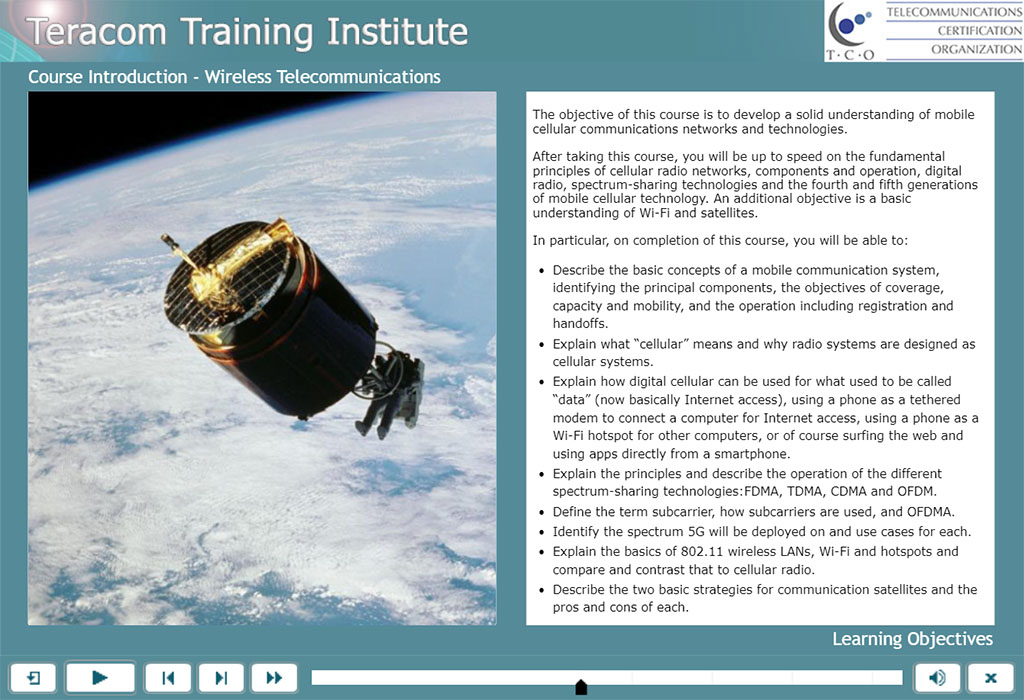
The Wireless Telecom course is a comprehensive course on cellular, WI-FI and satellites. We begin with basic concepts and terminology involved in mobile networks, including base stations and transceivers, handoffs, mobile switches and backhaul, cellular and digital radio concepts.
You'll understand how a cell phone call connects to a landline, and the different methods to use a smartphone's mobile Internet connection for other devices.
Without bogging down in the details, we'll review spectrum-sharing technologies by generation: 1G FDMA; 2G TDMA/GSM, 3G CDMA, and 4G and 5G OFDM.
We'll take some time to understand subcarriers, how modems represent bits on them, and how OFDMA dynamically assigns subcarrier(s) to users in 4G and 5G.
This is followed with 802.11 wireless LANs, commonly referred to as Wi-Fi: the frequency bands, system components, bitrates, and coverage for all of the versions up to 802.11ax which is Wi-Fi 6, the first version to implement full-duplex communications using OFDMA with multiple simultaneous devices and a theoretical 9.6 Gb/s. We'll also cover the security considerations of WPA-2 and WPA-3.
The course is completed with Geosynchronous Earth Orbit satellites and Low Earth Orbit satellites, including Iridium Next and Starlink.
On completion, you will be able to describe the basic concepts of a mobile communications system, identifying the principal components, the objectives of coverage, capacity and mobility, and the operation including registration and handoffs. You will be able to explain what "cellular" is and how digital cellular can be used for internet access, the principles and operation of the different spectrum-sharing technologies, and what a subcarrier is and how they are used in OFDMA. You will also be able to explain Wi-Fi, the frequencies used and the different 802.11 standards, and the similarities and differences between LEO and GEO satellites.
VoIP Phone System Components & Operation • LANs and WANs • Voice Packetization • VoIP Phones • SIP, Softswitches & SIP Trunking • MAC Address, DHCP, IP, UDP, RTP, QoS • Cloud • The Future
9 interactive multipart lessons, multiple-choice exam and certificate.
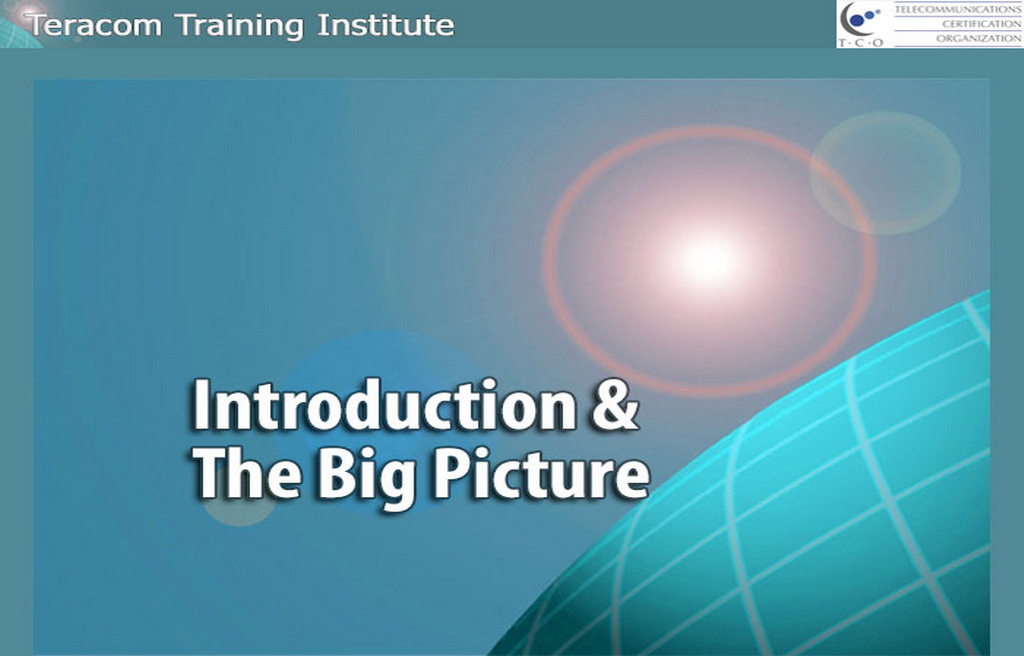
The Fundamentals of Voice over IP course gives you a foundation in everything Voice over IP, a broad survey of everything involved in moving speech from lips to ear in IP packets.
You'll learn the fundamental ideas and principles and the jargon and buzzwords of a VoIP telephone system including what it means and how it works.
We will cover the related and supporting technologies such as codecs, Ethernet MAC frames, and video over IP.
You'll gain a firm understanding of the fundamentals of VoIP telephone calls, and the different kinds of equipment involved.
We explain the terminals, Voice in Packets, SIP and Softswitches, SIP Servers, Call Managers, Media Servers, Gateways, LANs and WANs, the standards and the future which is IP Dial Tone.
On completion of this course, you will be able to explain the components of a VoIP phone and what they do; the end-to-end process of making a VoIP phone call through the codec, UDP, MAC frames and routers, and SIP servers; how to connect to the PSTN for a phone call; why video over IP is where the money is and what a video server is and where it is located; why a gateway is needed; VoIP carrier services including SIP trunking, MPLS VPN, Internet SD-WAN; Service Level Agreements and standards; and the impact on the traditional telephone system and the internet.
Analog • Voiceband • Circuit-Switching • Loops and Trunks • POTS • DTMF • LECs, CLECs and IXCs • SS7
8 interactive multipart lessons, multiple-choice exam and certificate. Produced in 2020.
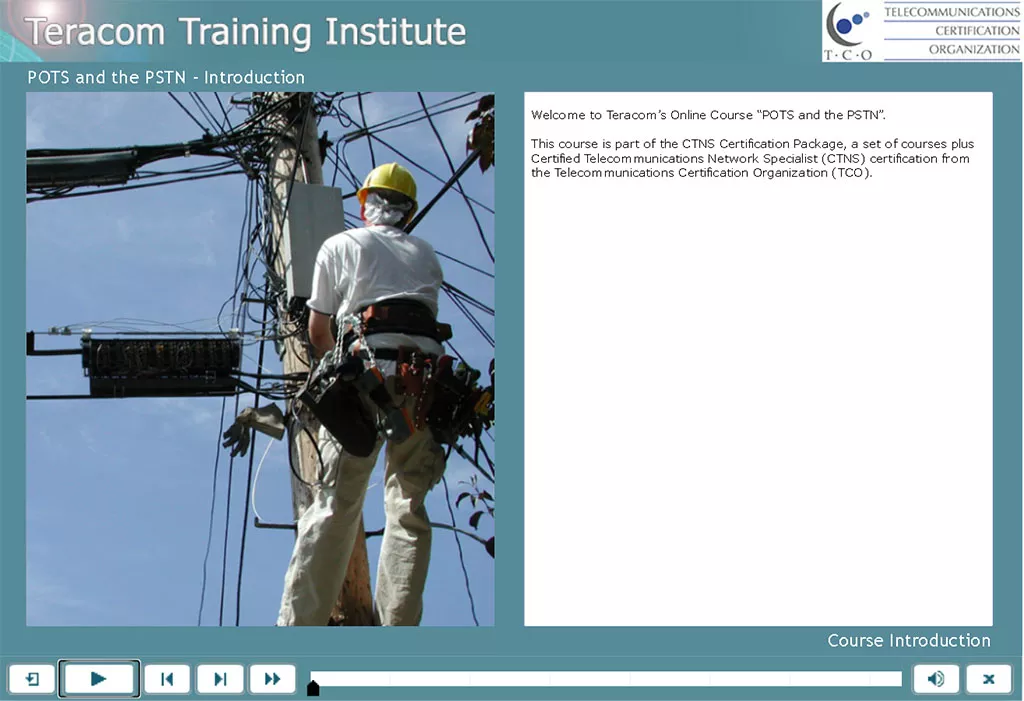
This course is dedicated to Plain Ordinary Telephone Service (POTS) and the Public Switched Telephone Network (PSTN). A cornerstone of a well-rounded base of knowledge of telecommunications is the Public Switched Telephone Network, its structure and operation built over 135 years and in operation in every country around the world – knowledge necessary for connecting IP telecom technologies which are steadily replacing the PSTN.
We begin with a history lesson, understanding how and why telephone networks and the companies that provide them are organized into local access and inter-city transmission, or as we will see, Local Exchange Carriers (LECs), Competitive Local Exchange Carriers (CLECs) and Inter-Exchange Carriers (IXCs).
Then we will establish a basic model for the PSTN and understand its main components: Customer Premise, Central Office, loop, trunk, outside plant, circuit switching, attenuation, loop length, and remotes.
Next, we'll cover aspects of telephony and Plain Ordinary Telephone Service, including analog, the voiceband, twisted pair, supervision and signaling including DTMF. The course is completed with an overview of SS7, the control system for the telephone network in the US and Canada.
On completion of this course, you will be able to draw a model of the PSTN, identify all of its components and technologies from voiceband analog to fiber to the neighborhood, and explain the characteristics and operation of the PSTN.
Protocols & Standards • OSI Model • Open Systems • Layers • Protocol Stacks • FedEx Analogy
14 interactive multipart lessons, multiple-choice exam and certificate. Produced in 2020.
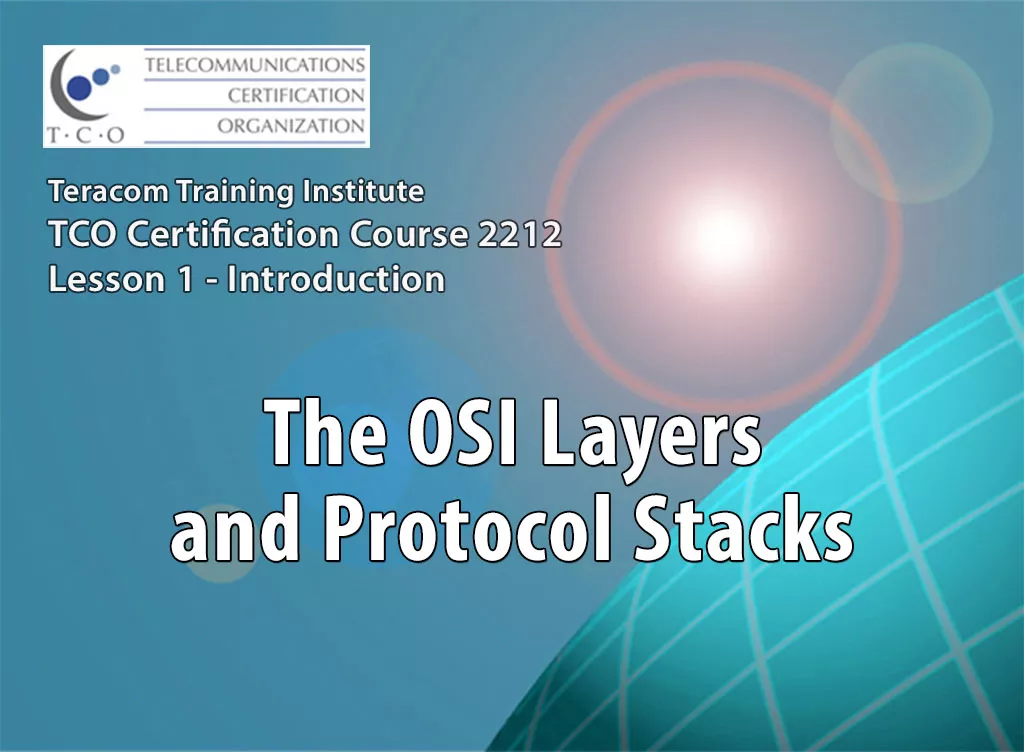
The OSI Layers and Protocol Stacks course establishes the OSI 7-Layer Reference Model as a framework for all of the subsequent discussions by identifying and dividing the functions into groups called layers. A framework is required to be able to discuss the separate issues separately and to sort out all of the functions to be performed.
We'll start our discussion with some definitions, then an overview of the OSI model, introducing the ideas of layers, layered architectures and protocol stacks.
Then we'll go through the layers individually and give examples of protocols like IP, TCP, LANs and DSL to see where they fit into the stack.
We'll finish off understanding how a protocol stack actually works in operation, and conclude the course with a review of different active standards organizations.
On completion of this course, you will be able to draw a model of the PSTN, identify all of its components and technologies from voiceband analog to fiber to the neighborhood, and explain the characteristics and operation of the PSTN.
The result is a protocol stack, one protocol on top of another on top of another to fulfill all of the required functions. To make this more understandable, this course includes the famous FedEx Analogy illustrating the concepts using company-to-company communications, and an analogy of Babushka dolls to illustrate how the protocol headers are nested at the bits level.
On completion of this course, you will be able to define a protocol and differentiate that from a standard, explain why a layered architecture is required, list the seven layers of the OSI model, the name, purpose and functions of each one, and explain how a protocol stack operates and where the protocol headers are located.
MAC Addresses • MAC Frames • Cable Categories • 1000BASE-T • Power over Ethernet • Office Wiring Plan • Layer 2 Switches • VLANs • Optical Ethernet • Wireless Ethernet (Wi-Fi) • Ethernet in the Core, MANs and PONs • SFP Transceivers • Fiber Types • Field Installation
7 interactive multipart lessons, multiple-choice exam and certificate. Produced in 2020.
The LANs, VLANs, Wireless and Optical Ethernet course is all about Ethernet: the fundamentals, the equipment, and wireless, fiber and twisted-pair copper cables, in-building, in the network core, MANs and PONs implementations.
We'll begin with the key idea of a broadcast domain which was implemented originally with a bus cable. We'll understand LAN interfaces, how each interface has a hard-coded MAC address, and how the address field is used to indicate which station a MAC frame is for, since it is received by all stations in the broadcast domain.
We'll next understand how the bus has moved inside a box called a LAN switch, Ethernet switch, or Layer 2 switch, how a switch learns the MAC address for each station, and how a LAN switch sends MAC frames to one or more stations.
Then we'll go over the key idea of VLANs. VLANs are software-defined broadcast domains which can be used to segregate traffic at the enterprise level by work area and by device type, and segregate traffic at the carrier level by customer.
You'll learn about the various standards for implementing Ethernet, IEEE 802.3 starting from 10BASE-5 to 1000BASE-T on various Categories of twisted-pair cables, Wi-Fi certification and IEEE 802.11 wireless LANs.
We'll finish with a comprehensive lesson on Optical Ethernet: that is Ethernet on fiber, the basis of the telecom network today. You'll learn how fiber cables are installed, how bits are represented, and how bulk fiber is connected to equipment by splicing. We'll review the Optical Ethernet standards covering from 1 Gb/s to 100 Gb/s.
IP Packets • Networks • DHCP • Routers • Static and Dynamic Addresses • Public and Private Addresses • NAT • IPv6
11 interactive multipart lessons, multiple-choice exam and certificate. Produced in 2020.
This is a comprehensive course on IP Networking, Layer 3 of the OSI Model, concentrating on IP addresses, IP routers and IP packets. The two basic principles of packet networks are bandwidth on demand and packet-switching.
First, we'll review channelized TDM plus its limitations, then understand bandwidth on demand or statistical TDM. Next, we'll understand how packet switching is implemented on the network through routers relaying packets from circuit to circuit, and how routers serve as a control point for network security. We'll then explain the term Customer Edge (CE), and understand a routing table's basic structure and content.
Then we'll cover the various aspects of IP addressing - needed to implement the packet switching: IPv4 address classes, static vs. dynamic addresses, dotted decimal notation, public vs. private addresses, DHCP, Network Address Translation, an overview of IPv6, and end with IPv6 address allocation and assignment.
On completion of this course, you will be able to define bandwidth on demand and its advantages, what a router does, the basic structure of a routing table, where routers are located, define the IPv4 address structure and dotted-decimal notation, explain how both static and dynamic addresses are assigned using DHCP, what private addresses are and how they are interfaced to the public IP network, and the structure, allocation and assignment of IPv6 addresses.
Carrier Packet Networks • Technologies • Integration &s; Aggregation • SLAs • CoS • MPLS • MPLS VPNs
11 interactive multipart lessons, multiple-choice exam and certificate. Produced in 2020.
This is an up-to-date and comprehensive course devoted to the terminology, configuration, technologies and operation of carrier packet networks and services, how they are implemented, and how customers connect to the network.
We'll demystify buzzwords like carrier packet networks and services, Customer Edge, Provider Edge, Service Level Agreement, traffic profile, Class of Service, QoS, Differentiated Services, virtual circuits, integration, convergence and aggregation, and MPLS and other network technologies, and how they relate to TCP/IP.
The previous course used a private network as the simplest framework to explain bandwidth on demand, packets, routers, and network addresses. In this course, we will apply the same idea at the carrier network level by replacing the dedicated lines between the customer locations with a carrier's bandwidth on demand service.
In this course, we'll focus on understanding virtual circuits, a powerful traffic management tool, how they are implemented through MPLS, and how MPLS can be used to implement convergence, aggregate traffic and provide differentiated services.
The course is completed with a lesson on "MPLS services" compared to Internet service.
On completion of this course, you will be able to draw a model of a carrier packet network, define the terms Customer Edge and Provider Edge, explain what a traffic profile is and how that relates to a Service Level Agreement, the purpose, components, terminology and operation of MPLS, and how MPLS can be used to implement integration or convergence, aggregation and differentiated classes of service – what people mean when they say "MPLS service" and its pros and cons compared to Internet service.
Packages with Certification
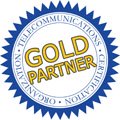 Teracom is a Gold Training Partner of the Telecommunications Certification Organization, authorized to administer exams for TCO certifications on the myTeracom Learning Management System and award TCO certifications.
Teracom is a Gold Training Partner of the Telecommunications Certification Organization, authorized to administer exams for TCO certifications on the myTeracom Learning Management System and award TCO certifications.
TCO certification is proof of your knowledge of telecom, datacom and networking fundamentals, jargon, buzzwords, technologies and solutions. It's backed up with a certificate and a letter of introduction.
CTNS Certified Telecommunications Network Specialist
(recommended choice)This package includes eight Teracom online courses and TCO CTNS certification with certificate, letter of reference and all of the other great benefits of TCO Certification:
- L2241 Introduction to Broadband Converged IP Telecom
- L2206 Wireless Telecommunications
- L2221 Fundamentals of Voice over IP
- L2201 The PSTN
- L2212 The OSI Layers and Protocol Stacks
- L2211 LANs, VLANs, Wireless and Optical Ethernet
- L2213 IP Addresses, Packets and Routers
- L2214 MPLS and Carrier Networks
If you want to get this knowledge, but don't need (or don't want) to write the multiple-choice course exams to get a certificate... the exams are optional, so feel free to register for a certification package to take that set of courses and benefit from the discounted price - and do the exams only if you want to. With the Unlimited Plan Plan, you can repeat the courses as many times as you like!
Certified Wireless Analyst
This package includes three Teracom online courses and TCO CWA certification with certificate, letter of reference and all of the other great benefits of TCO Certification:
- 2231 Wireless Fundamentals
- 2232 Mobile Communications
- 2233 Fixed Wireless: Wi-Fi
Certified VoIP Analyst
This package includes six Teracom online courses and TCO CVA certification with certificate, letter of reference and all of the other great benefits of TCO Certification:
- 2221 Fundamentals of Voice over IP
- 2222 VoIP Architectures and Implementation Choices
- 2223 Softwitches, SIP, and VoIP Call Setup
- 2224 Voice Packetization, Codecs and Voice Quality
- 2225 SIP Trunking & Carrier Connections
- 2226 IP Network Quality: CoS, QoS, MPLS AND SLAs
Certified Telecommunications Analyst
This package includes four Teracom online courses and TCO CTA certification with certificate, letter of reference and all of the other great benefits of TCO Certification:
- 2201 Fundamentals of Telephony and Voice over IP
- 2202 Telecom Equipment
- 2203 The Telecommunications Industry
- 2204 Digital
- 2205 Transmission Systems and Fiber Optics
- 2206 Wireless Telecommunications
- 2207 Introduction to Datacom and Networking
- 2208 Data Coding, Frames and Packets
- 2209 Modems: Representing Bits on Radio and Copper
- 2210 The Network "Cloud" and Service Implementation
- 2212 The OSI Layers and Protocol Stacks
- 2211 Ethernet, LANs and VLANs
- 2213 IP Networks, Routers and Addresses
- 2214 MPLS and Carrier Networks
- 2215 The Internet
- 2216 IP Security
Certified Telecommunications Subject Matter Expert
This package includes includes the four certifications with a hand-signed framed certificate, letter of reference and all of the other great benefits of TCO Certification:
- CTNS Certified Telecommunications Network Specialist
- CTA Certified Telecommunications Analyst
- CVA Certified VoIP Analyst
- CWA Certified Wireless Analyst
CIPTS Certified IP Telecom Network Specialist
This package includes four Teracom online courses and TCO CIPTS certification with certificate, letter of reference and all of the other great benefits of TCO Certification:
- L2212 The OSI Layers and Protocol Stacks
- L2211 LANs, VLANs, Wireless and Optical Ethernet
- L2213 IP Addresses, Packets and Routers
- L2214 MPLS and Carrier Networks
Get started today to make this invaluable addition to your knowledge and skills!

Please visit Teracom Training Institute for:
• Instructor-Led Training Courses
• Online Interactive Courses
• Quizzes and Exams
• Group Training Online
• Textbooks
• CTA Study Guide
• eBooks
• Free Tutorials
• Free Training
• Free Course Lessons
• Reference Book
• Telecommunications training
• MPLS training course
• Broadband, telecom, datacom,networking course
• VoIP, SIP, Security, 5G IoT course
• Broadband, telecom, datacom, 5G, networking, VoIP, security, IoT course
• Private Onsite Training
• Wireless training course
• VoIP training course
• IP Call Center contact center course
• IPv6 training course
• Telecom course online
More telecom training and network training course sites:
• telecom course online
• telecommunications certifications
• telecom training channel
• telecommunications certification
• telecommunications classes
• telecommunications courses
• telecommunications training
• telecommunications tutorials
• telecommunications in canada
• teracom canada
• teracom TV
• network training course
• network course
• continuing professional education (CPE) credits online
• fundamentals of telecommunications
• IP certification
• IPv6 course
• IPv6 course online
• IPv6 training course
• IPv6 training online
• IPv6 training
• IPv6 training
• MPLS certification
• MPLS training
• online certification
• telecom course online
• seminars on telecommunications
• telecommunications seminars
• telecoms certifications
• telecom certification
• telecom classes
• telecom courses
• Telecom 101
• telecom courses
• telecommunications for non-engineers
• telecommunications seminars
• telecommunications seminar
• telecommunications training seminar
• telecommunications training seminars
• telecommunications training
• telecommunications training
• telecom training
• telecom basics
• voip training
• voip certification
• wireless certification
Thank you!
Copyright © http://www.network-training-course.com/ All rights reserved.
